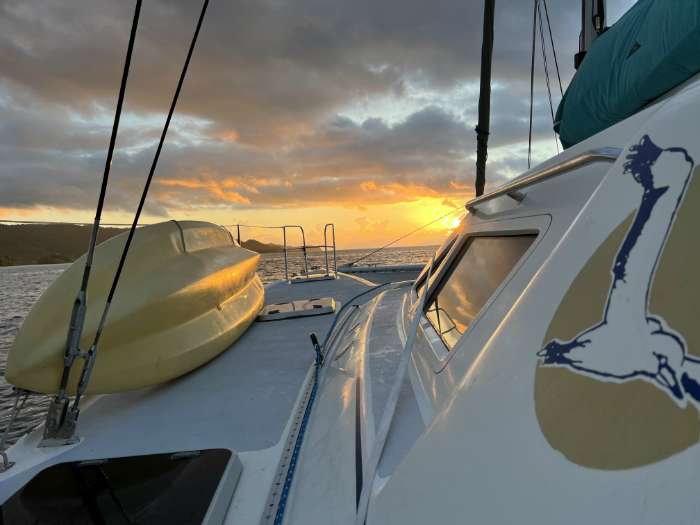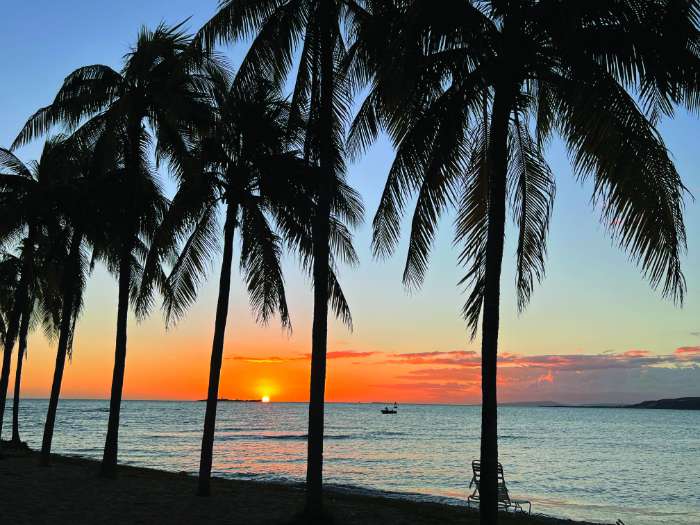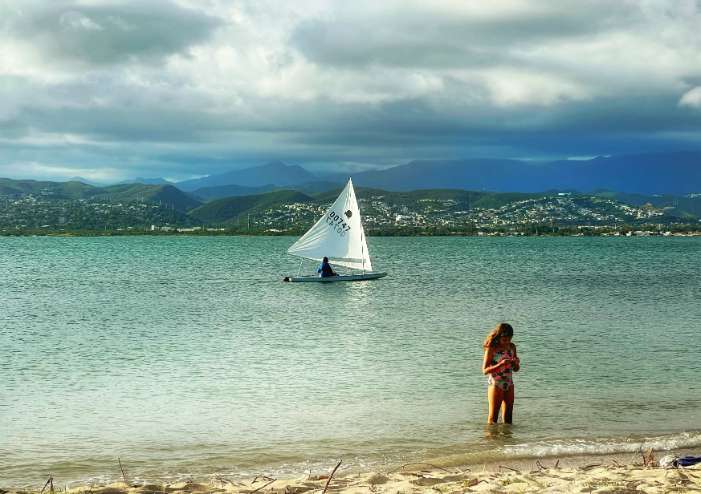A Cruising Sailor Finds Lessons in Imperfect Sailing
After a half year in the protected waters of Luperon, Dominican Republic, pointing our bows east out of the channel became a sudden rodeo ride. Forecasted four-foot seas were more like nine-foot broncos tossing the boat... and my stomach.
I started the mental “99 Bottles of Beer on the Wall” of hours and minutes left as we crashed our way east. Twenty-five hours to go. Vomit. Twenty-three hours to go. Vomit. Twenty-one hours to go. Vomit. Nineteen hours to go. Vomit. This is the point where a cruising sailor starts dreaming about Zillow and a home in the suburbs. I would have actually scrolled through Zillow to get my mind off of how awful I felt, but that required too much energy. Vomit. Seventeen hours to go.

My daughter and I cuddled in my berth together with a bucket while my son and husband, who apparently have stomachs made of steel, took all of the watches that first 24 hours. Some diehard evangelists of the book “The Gentleman’s Guide to Passages South” by Bruce Van Sant told us we should only sail overnight and make three stops along the way to avoid the full claws of the trade winds that would be pushing wind and waves against us along the north coast of Hispaniola. But Bruce Van Sant didn’t cruise with kids or dogs.
And the forecast showed a rare disruption in the trades thanks to a late season hurricane passing north of us, so the wind was supposed to be lighter than normal. And it was. But the seas were more boisterous than forecast, and so we bashed. We didn’t want to pull over to anchor and turn a 24-hour trip into a three-day ordeal using the Van Sant method, especially knowing that the winds were supposed to kick up to full trades in just a day. As far as we could tell, these pullover spots didn’t have good shore access for the dogs, so we pressed on. Vomit. Twelve hours to go.
I stumbled out of my bunk around 2 a.m. to see if anyone needed a rest from the helm. I went up, looked at my son who was happy under the stars, asked how he was doing, and vomited over the rail right next to him. “Go back down below mom. We got this.” Seven hours to go.
Right around sunrise I woke up because of an odd feeling I had. It was the feeling of not feeling sick. It was the feeling of settled seas. I stumbled out again and saw that we were in the sheltered waters of Samana Bay. We glided into Samana where we would wait a few days in a marina for the next window to cross the Mona Passage to Puerto Rico.

The marina had a pool, and ice, and fuel, and pizza, but it also had terribly “rolly” slips. At first I was annoyed at feeling as if we were underway while tied up in a slip, but I told my daughter it was training. We were training our stomachs for the next leg. Because of this rolly slip we will be acclimated when we head out again. While it seemed like one of those lies a parent tells a kid to make them feel better, it actually turned out to be true.
When we left three days later and made the next passage, there were no green tummies. We were still motoring into the trades, but this time our bodies were as ready as the boat. We took medicine the night before. We used the single earplug trick. Whatever it was that worked, we were grateful to be feeling 100 percent again. We also used weather expert Chris Parker to help us pick a conservative weather window that gave us a very smooth Mona Passage crossing.
We got comfortable in Puerto Real, Puerto Rico, but knew we had to press on and “make some easting” along the south coast. With no break in the trades on the horizon, we leaned into the Van Sant method a little more, leaving just before dawn before the winds kicked into full force, and anchoring by about 11 a.m. before it got too sporty. All good in theory, but we were still experiencing the full pinch of the Thorny Path. The seas built as we rounded the very southeast corner of Puerto Rico. The rodeo was on again.
The difference this time was that our tummies acclimated. The knowledge that there was a safe harbor to tuck into a few hours away rather than a day or two made all the difference in what we told ourselves we could handle. Unlike Hispaniola, Puerto Rico has one protected anchorage after another to duck into. You take your lumps, but you can pick and choose how long you ride the bluewater bulls before you pull over and chill for a day or three, or week or two.

The paradigm shift from vomit zombie to nautical cowboy helps make each mile you crawl along the Thorny Path to windward more enjoyable. On watch, I’d stare at the bows of our boat as they pointed up to the clouds, and crash down into a trough of a wave showering me with spray. Rinse, repeat, ad infinitum. But I learned how to use the rhythm as a salty, messy meditation, focusing me completely in the moment. No thinking about where we had been or where we were going or what I needed to get done.
I would just look at the sky, the waves, and the flying fish, only thinking about that very moment. A weird large wave would pass. I’d watch it march on towards the horizon, wondering who she was off to meet next. That was a big wave, and now she’s gone. Adios wave. Acknowledge it and let it go. That’s the lesson of imperfect sailing days on the Thorny Path.
About the author: Longtime SpinSheet columnist Cindy Wallach is cruising in the Caribbean with her husband, two children, and two dogs on their St. Francis 44 catamaran Majestic.
Find more cruising articles here.




